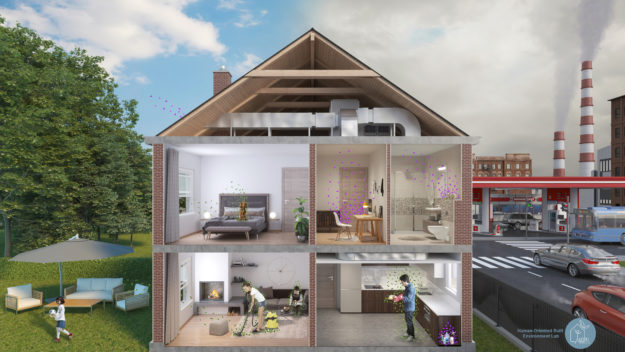Investigation of the unintended consequences of the use of air cleaning devices on indoor air chemistry
By the end of July 2021, the ongoing global COVID-19 pandemic had directly or indirectly caused the death of more than four million people. This worldwide public health crisis also caused severe economic and social disruption, which may have a profound impact on the quality of life. Interventions to minimize or prevent the transmission of COVID-19 are urgently needed to end the pandemic. Airborne transmission has been identified as an important pathway for person-to-person transmission. As an infected individual talks and breathes, they release aerosol particles containing COVID-19 from their respiratory tract. If these particles are sufficiently large, they can remain suspended in the air from a matter of seconds to as much as one or two days. Transmission of COVID-19 was found to be substantially higher indoors than outdoors due to the constrained space and the poor dilution effect in indoor environments, which can elevate the abundance of airborne infectious particles, resulting in greater inhalation exposures and infection risks. To prevent indoor transmission, a variety of active cleaning technologies have been adopted to remove or inactivate the airborne virus. One of the key strategies is to use ultraviolet (UV) and ionization air disinfection devices, which have been widely implemented in buildings during the pandemic.
Indoor air is a complex chemical soup with significant emissions of gas-phase pollutants from humans and their activities, such as cooking, cleaning, and use of chemical products. While the indoor UV and ionization devices are intended for air disinfection of airborne viruses during the pandemic, they can also provide high-energy UV irradiance to gas-phase chemicals and produce reactive ions from high voltage electrodes. These can further induce a variety of unintended chemical reactions indoors, especially with abundant emissions of air pollutants from human activities. These reactions potentially produce a broad range of air disinfection intermediates and byproducts, including a variety of gaseous compounds and secondary organic aerosols (SOAs). The byproducts may be odorous, can irritate the respiratory system, eyes, and skin, and can generate cellular reactive species upon inhalation, which have negative impacts on occupant comfort and health. Since humans spend more than 90% of their time indoors, staying in such an environment and being exposed to the byproducts may lead to acute and chronic effects on the human respiratory system and health. However, the unintended consequence of air cleaning technologies on indoor air chemistry and human exposure remains significantly understudied. Given the rapid acceleration of the application of air cleaning devices and the potential health effect, this important knowledge gap must be filled as a matter of urgency.
In this study, the HOBEL and LAPI research groups plan to conduct a set of novel experiments to investigate how UV and ionization air disinfection techniques affect indoor air quality. Our primary goals are: (1) to characterize byproduct formation (e.g. SOAs) and transformation of gaseous air pollutants due to the use of air disinfection devices during different indoor activities, and to assess occupant exposure; (2) to understand the influence of the operational conditions of building ventilation systems (e.g. humidity control, ventilation rate) on the transformation processes; and (3) to investigate the fate and removal mechanisms of the air disinfection byproducts. The gas- and particle-phase air pollutants will be monitored by the state-of-the-art online mass spectrometer and aerosol instruments. To ensure that the experimental conditions are as realistic as possible, the experiments will be conducted at EPFL Fribourg, which houses a unique environmental chamber with advanced building control technologies to facilitate building research in real-world scenarios. Two types of commercially available air disinfection products will be tested, including a portable UV air cleaner and a portable ionization air cleaner.
The proposed study is expected to provide new fundamental insights into the formation and fate of air disinfection byproducts and human exposure science. The chemical analysis on the molecular level will reveal the mechanisms of physical and chemical conversions of indoor air pollutants due to the interaction with UV and ionization devices. The results will be useful for researchers to assess occupant exposure and health risks, and for building designers and operators to devise pollution control and ventilation strategies to guarantee a healthy built environment.
